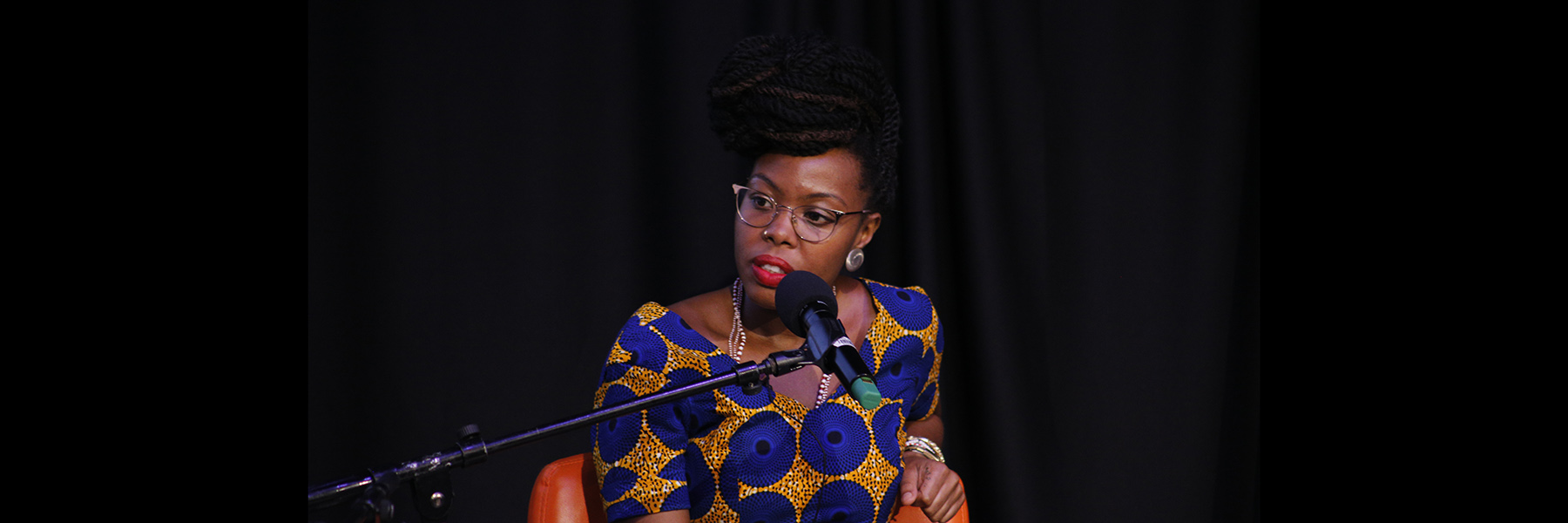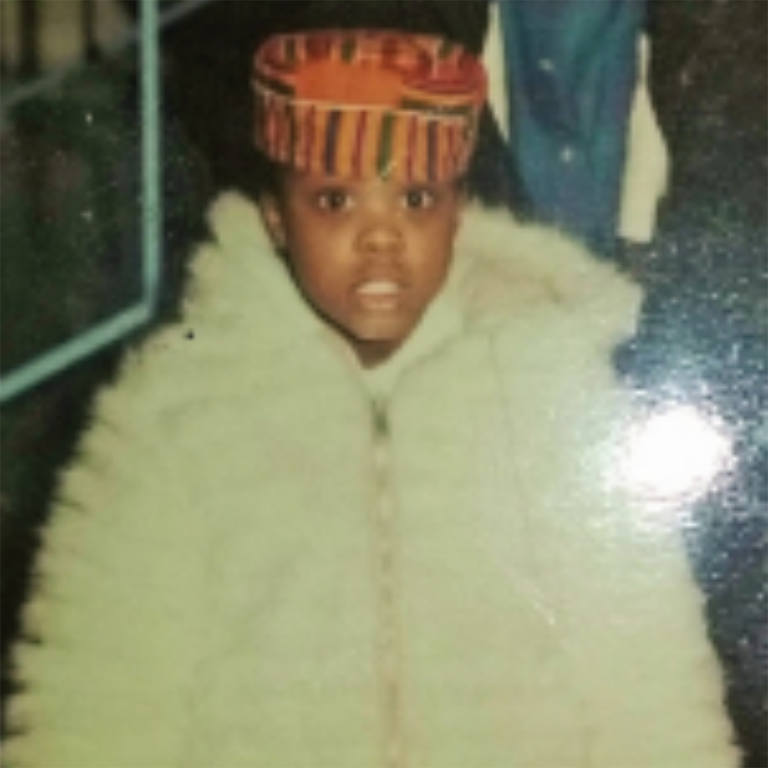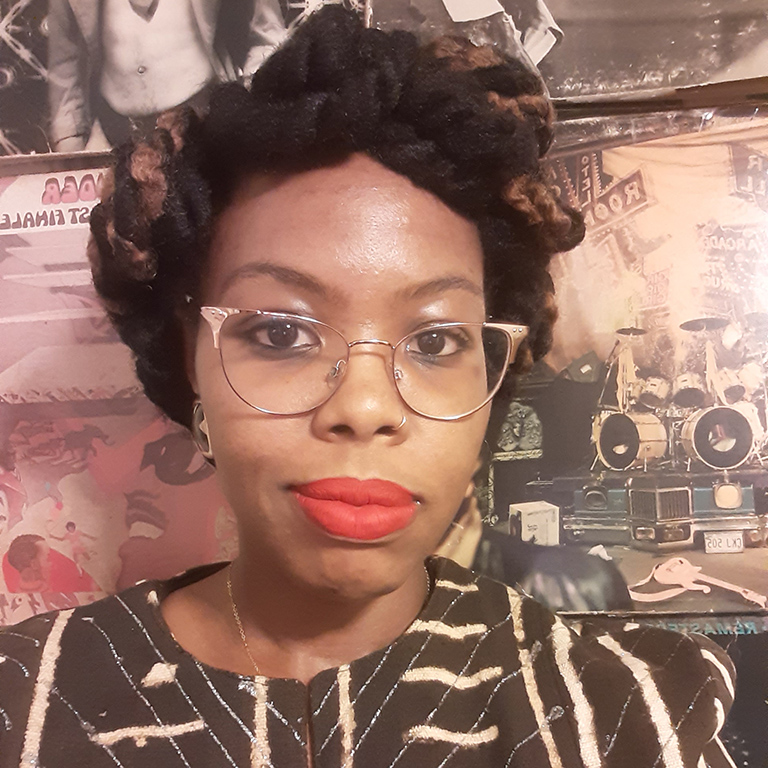This is how Nia I’man Smith describes herself on THE BLACK CONNECTION, her arts-rich website filled with music, poetry, a podcast, and merchandise that pays homage to the African Diaspora. Smith graduated from Howard University with a Bachelor of Arts in Afro-American Studies and earned her Master of Science in Museum Education from Bank Street College of Education. Her professional experiences include positions with the American Poetry Museum, Brooklyn Museum, Studio Museum in Harlem, and Weeksville Heritage Center. Since 2021, she has been a doctoral student in ethnomusicology at IU Bloomington, with a focus on ancestor veneration in Black music and a graduate assistant with the Archives of African American Music and Culture.
Q: What led you to study at Indiana University Bloomington, and can you describe the focus of your graduate work?
A: Indiana University Bloomington has a noted reputation for its commitment to institutionalizing the study, performance, and preservation of Black music which was fostered by the visionary work of Dr. Herman C. Hudson, Dr. Portia K. Maultsby, Dr. Mellonee V. Burnim, and countless other directors, educators, administrators whose legacies fill the IU Bloomington Black music archive. These titans paved the way for the cadre of Black ethnomusicologists who have taught and/or studied here such as Dr. Alisha Lola Jones, Dr. Tyron Cooper, Dr. Fredara Hadley, and many others whose scholarship I greatly admire and whose dedication and care I aspire to emulate. Equally, I knew I wanted to study somewhere that had a facility dedicated to the preservation and sharing of the very music that has soundtracked my life, and the Archives of African American Music and Culture was, and is, exactly that place.
My graduate work explores the presence of ancestor veneration within Black music with a focus on the question, “How do Black musicians—past and present—venerate ancestral musical, familial, and/ or cultural lineages and traditions through sonic, lyrical, and/or performance choices?” I’m still shaping this question, but it largely encompasses what guides my listening, thinking, and interpretation of Black music.
Q: How did THE BLACK CONNECTION come to be, and why is it important to you?
A: THE BLACK CONNECTION initially started as an alias I blogged under as a “Social Capital Correspondent” for the organization Campus Progress the summer I graduated from Howard University. My best friend, Laura Perez, and I were the only correspondents who attended Howard, so it was really important to me to write about the D.C. I knew—a D.C. with Black-owned bookstores like Sankofa, late-night parties on U St. at Bohemian Caverns or Marvin dancing to the music provided by DJ Jahsonic and DJ Underdog, and poetry nights at Mocha Hut and Bar Nun. In naming myself THE BLACK CONNECTION, I wanted to connect readers to D.C’s vibrant, Black cultural arts scene and pay homage to the people and places that shaped that period of my life as a young Black woman and lover of the arts. The name also perfectly integrated my love of Black music and film by being a nod to the song “Black Connection” by hip hop duo Camp Lo, and the ‘70s Blaxploitation film of the same title.
After the blog ended, THE BLACK CONNECTION became a multi-platform exploration and archive of all the things that make up my creative being—poetry, visual art, music, apparel design, etc.—and above all a love letter to Black culture in all its manifestations.
Q: Can you describe your work with AAAMC and your recent trip to Cincinnati with IU?
A: I work as a Graduate Assistant and a large part of my work has been cataloging our collections—particularly the archival collection of musician, composer, arranger, and educator Mr. Warren Smith. As someone new to archival work, it has been a wonderful opportunity to learn the ins and outs of preservation while also engaging our motto of thinking about creative and accessible ways to “bring our archives to life.” Additionally, I contribute to our social media platforms to ensure we remain publicly visible and support public programs, such as the recent "The Black Church Mixtape: A Virtual Listening Party" in partnership with the Neal-Marshall Black Culture Center and Black Music Honors honoring Bishop Hezekiah Walker and Dr. Teresa Hairston.
Recently, we took a trip to Cincinnati to film for the upcoming episode of our docuseries, "AAAMC Speaks," which will feature Reggie and Vincent Calloway, whose contributions to Black music via the band Midnight Star, as well as joint production and songwriting ventures are heard to this day. During the trip, we were able to interview former bandmates, managers, friends, and family members of the Calloways and document the induction of Midnight Star to the Cincinnati Black Music Walk of Fame. It was such an honor to be able to interact with them and the many people who make up the rich constellation of their musical history, and Cincinnati’s Black music history at large.
Q: What are you reading/watching/listening to these days that you would recommend?
A: To be honest, after the end of the spring semester I didn’t want to see another book for while! However, this summer, I’ve been slowly reading "The Power of Black Music: Interpreting Its History from Africa to the United States" by seminal Black music scholar Dr. Samuel A. Floyd, Jr. This book was initially introduced to me by a dear friend and fellow Black music scholar, Amalia Mallard, and I was later reintroduced to it in Dr. Alisha Lola Jones’ Black Music Research course during my first semester. In that course, Dr. Jones implored us to “know our intellectual genealogy” and for me, and many others in Black music research, Dr. Floyd is a foundational part of that intellectual genealogy. The book is a stirring and clear read that beautifully contextualizes the past, present, and future of Black music.
Admittedly, I’m not a big TV/streaming person outside of a few select shows but what I will always recommend as a watch is the 1995 teleplay version of August Wilson’s, "The Piano Lesson." The cast, including Charles S. Dutton, Alfre Woodard, and Courtney B. Vance, is absolutely dynamic! Also, the play deals with themes of ancestor veneration and incorporates music so it perfectly aligns with my personal and scholarly interests.
In terms of music, I’m all over the place; on any day you can catch me listening to anything across the vast past/present/future of the Black musical continuum, but if I am to recommend what I’ve been listening to lately it is Abbey Lincoln’s, “You And Me Love” from her 1978 album, "People In Me." This is an album I recently rediscovered in my record collection, and when I heard this song it became one I instantly put on repeat. I suggest listening to it when day begins to give itself to the magic of the night.
Q: What’s your favorite thing about Bloomington? What, if anything, has surprised you about living in Indiana?
A: Landlocked Music. A town is only as good as its record store, and Landlocked pleasantly surprised me with its excellent collection of jazz and R&B; I go there at least twice a month and have added some gems to my collection as a result. What has surprised me about living in Indiana is all the deer—they are EVERYWHERE and I LOVE IT!




